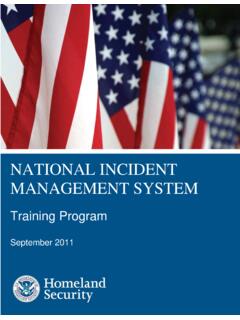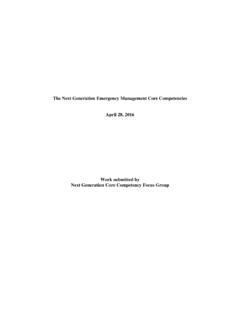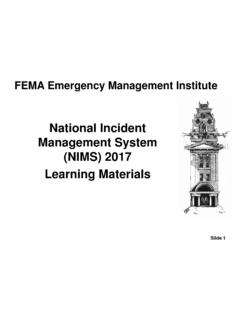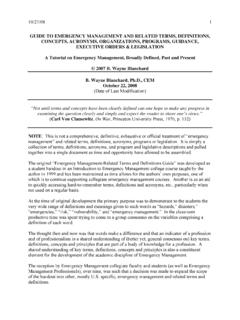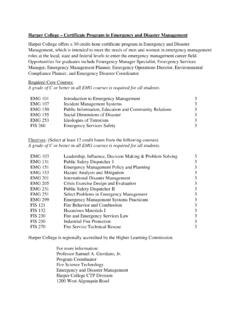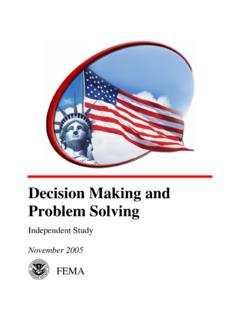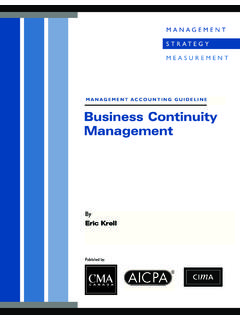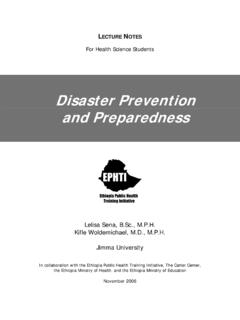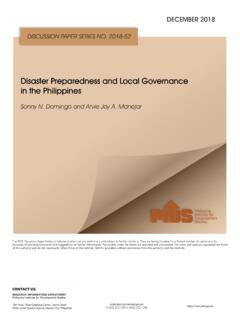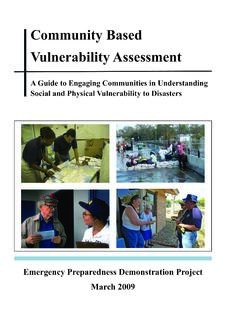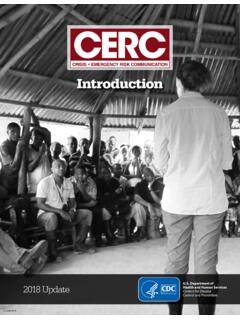Transcription of Federal Emergency Management: A Brief Introduction
1 CRS Report for CongressPrepared for Members and Committees of Congress Federal Emergency management : A Brief Introduction Bruce R. Lindsay, Coordinator Analyst in American National Goverment November 30, 2012 Congressional Research Service 7-5700 R42845 Federal Emergency management : An Introduction Congressional Research Service Summary The Federal government plays a significant role in Emergency management , which generally refers to activities associated with avoiding and responding to natural and human-caused hazards. Emergency management in the United States is highly decentralized and contextual in nature: activities often involve multiple jurisdictions as well as a vast number of agencies, nongovernmental organizations, and private sector entities.
2 In addition, the number and type of actors involved in an incident will vary tremendously depending on the context and severity of the event. Similarly, the legal framework through which Emergency management functions and activities are authorized is also decentralized and stems from multiple authorities. Congress annually appropriates funds for a wide range of activities and efforts related to Emergency management . For example, between 2005 and 2011 Congress provided an average of $12 billion annually to the Federal Emergency management Agency, the lead Federal agency responsible for disaster relief through regular and supplemental appropriations. Congress has also invested over $120 billion through various Federal agencies to help the Gulf Coast Region recover from the hurricanes that hit the Gulf Coast in 2005 and 2008.
3 In recent years congressional interest in Emergency management has focused on funding, program administration, and program coordination both among Federal agencies and state Emergency management agencies. This report provides an Introduction to the principles and foundations of Federal Emergency management in the United States and a description of the activities of the Federal agencies that provide assistance, focusing primarily on the Federal Emergency management Agency, but also including information on the National Guard, Department of Agriculture, Department of Defense, Army Corps of Engineers, Department of Health and Human Services, Department of Housing and Urban Development, Department of Transportation, Environmental Protection Agency, Forest Service, and Small Business Administration.
4 This report is designed to provide Members of Congress and congressional staff with a general overview of principles and foundations of Federal Emergency management in the United States as well as the types of activities provided by various Federal agencies. The report begins with a description of the four phases of Emergency management : (1) mitigation, (2) preparedness, (3) response, and (4) recovery, and includes examples of some of the activities that take place in each of these phases. The report then discusses a recent movement at the Federal level to carry out these phases of Emergency management through a system of frameworks. The frameworks include (1) the National Prevention Framework, (2) the National Protection Framework, (3) the National Mitigation Framework, (4) the National Response Framework, and (5) the National Disaster Recovery Framework.
5 The frameworks are used to designate roles and responsibilities and coordinate various activities. Next, this report describes the process for requesting Federal assistance for major disasters, emergencies, and fire suppression. The declaration section also includes Brief summaries of the types of assistance provided through each type of declaration. This discussion is followed by description of Federal -to-state cost shares, how Federal assistance is funded, and the process through which FEMA requests assistance from other Federal entities. The section then provides a description of the close-out process the process in which FEMA terminates its recovery efforts. The report includes a discussion of key Federal laws and policies that influence Federal Emergency Federal Emergency management : An Introduction Congressional Research Service management , and concludes by highlighting some of the Federal activities that take place in response to emergencies and disasters.
6 Federal Emergency management : An Introduction Congressional Research Service Contents Introduction .. 1 Key Concepts and Approaches in Emergency management .. 1 All-Hazards Model .. 1 NIMS and ICS .. 2 Phases of Emergency management .. 2 Mitigation .. 3 Preparedness .. 3 Response .. 3 Recovery .. 3 The Framework Approach .. 4 National Prevention Framework .. 4 National Protection Framework .. 5 National Mitigation Framework .. 5 National Response Framework .. 5 National Disaster Recovery Framework .. 6 Federal Assistance through Stafford Declarations .. 6 Major Disaster Declarations .. 7 Assistance Provided Under Major Disaster Declarations .. 7 Emergency Declarations .. 8 Assistance Provided Under Emergency Declarations.
7 9 Fire management Assistance Grant Declarations .. 9 Assistance Provided under Fire management Assistance Grants .. 9 Cost-Shares .. 9 Disaster Relief Fund .. 10 Closeout .. 10 Other Types of Federal Declarations .. 11 Federal to Federal Support .. 13 Stafford Act Incidents and Mission Assignments .. 13 Non Stafford Act Incidents .. 13 Other Key Federal Laws and Policies .. 13 Disaster Mitigation Act of 2000 .. 13 Post Katrina Emergency management Reform Act .. 14 Homeland Security Presidential Directives .. 14 Homeland Security Act .. 15 National Oil and Hazardous Substances Pollution Contingency Plan .. 15 Key Federal Assistance for Disaster Response and Recovery .. 17 National Guard .. 17 Department of Agriculture.
8 18 Department of Defense .. 19 Immediate Response .. 19 Requests for Assistance .. 19 Army Corps of Engineers .. 20 Department of Health and Human Services .. 21 Department of Housing of Housing and Urban Development .. 21 Federal Emergency management : An Introduction Congressional Research Service Community Development Block Grants .. 22 Department of Transportation .. 22 Federal Highway Administration .. 23 Environmental Protection Agency .. 23 Forest Service .. 24 Small Business Administration .. 25 Ta b l e s Table 1. Other Types of Federal Declarations .. 12 Contacts Author Contact 26 Key CRS Policy Experts .. 26 Federal Emergency management : An Introduction Congressional Research Service 1 introduction Emergency management generally refers to activities associated with avoiding and responding to natural and human-caused hazards.
9 Emergency management in the United States is highly decentralized and contextual in nature. Multiple jurisdictions as well as a vast number of agencies, nongovernmental organizations, and private sector entities are often involved. In general, Emergency management begins locally, but the Federal government plays an important role when a state requests assistance. Consequently, the number and type of actors involved in an incident vary tremendously depending on the context and severity of the event. Similarly, the legal framework through which Emergency management functions and activities are authorized is also decentralized and stems from multiple authorities. This report provides Members of Congress and their staffs with an Introduction to the principles and foundations of Federal Emergency management in the United States.
10 It examines the activities of several Federal agencies including the Federal Emergency management Agency (FEMA) the National Guard, Department of Agriculture, Department of Defense, Army Corps of Engineers, Department of Health and Human Services, Department of Housing and Urban Development, Department of Transportation, Environmental Protection Agency, Forest Service, and Small Business Administration. In addition, this report discusses the four phases of Emergency management : (1) mitigation, (2) preparedness, (3) response, and (4) recovery; the process for requesting Federal assistance for major disasters, emergencies, and fires; and the types of assistance provided through each type of Stafford Act declaration.
